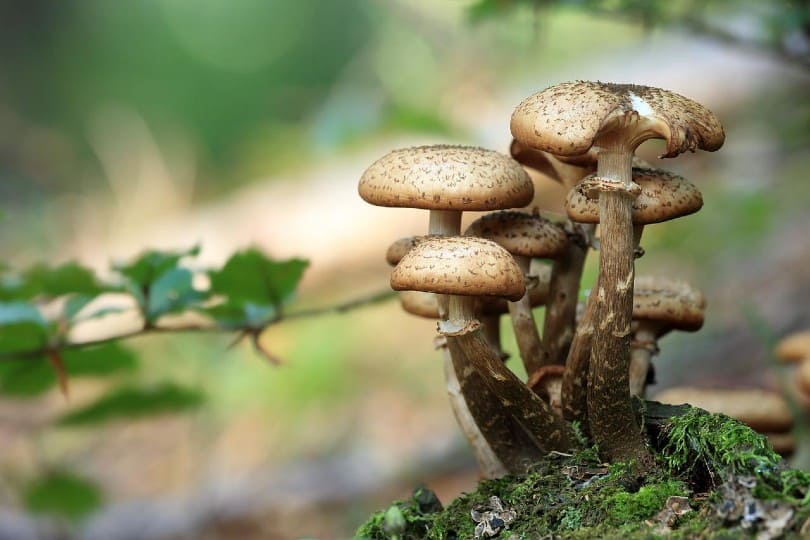Dogs explore the world around them using their nose and their mouth. Indeed, dogs sniff everything they come across and then some. So, it’s no surprise that they get into things they shouldn’t from time to time. Many mushrooms are poisonous when eaten, and dogs are no exception to the rule.
You shouldn’t let your dog eat mushrooms because most pet parents are not well-versed enough in mycology to make accurate judgments about which mushrooms are safe for their dogs to eat; they can barely decide which mushrooms are safe for themselves!
Where Do Toxic Mushrooms Grow?
Mushrooms grow best in warm, wet weather. They’re surprisingly survivable fungi that can grow in wooded areas, rocky cliffs, grassy parks, and where things decompose. Mushrooms can grow year-round, but spring and early fall are the best seasons to collect mushrooms in most areas if you can safely.
Unfortunately, toxic mushrooms grow in the same conditions that non-toxic mushrooms do. So, there’s no way to know which mushrooms are toxic just by where they’re increasing. You’d have to be able to identify the mushroom itself to see if it’s poisonous or not.
What Do Toxic Mushrooms Look Like?
For the most part, toxic mushrooms don’t look that different from non-toxic ones. You’d have to be able to correctly identify all the mushrooms to know for sure whether a mushroom will be toxic when eaten. Pet parents should assume that any mushroom they see is poisonous rather than trying to learn all the mushrooms by heart.
However, foraging for mushrooms and other plant species has become a popular pastime, with the cost of living increasing each year drastically and American wages not keeping up. Many people have taken up living off the land by foraging and gardening to try and make up for some of the difference.
We recommend that any person whose pet consumes a mushroom assume that the mushroom is toxic. The faster you act on your pet’s ingestion, the better your pet’s prognosis. This is especially true if your pet has eaten a mushroom that you cannot recover to find out what kind of mushroom it is. It’s better to be safe than sorry.

Is Mushroom Toxicity Deadly?
Yes, it can be! The severity of the toxicity will be determined by the type of mushrooms your dog ingests and the number of mushrooms they consume. While many mushrooms—even toxic ones—may only cause some gastrointestinal distress that will clear up on its own at home, some mushrooms are extremely deadly to mammals who consume them. Unfortunately, even with treatment, mushroom toxicity can still take your pet’s life. So, aim for prevention rather than treatment.
What Are the Symptoms of Mushroom Toxicity?
The symptoms of mushroom toxicity also vary by the type of mushroom. There are four main categories of toxins that can be found in mushrooms.
Gastrointestinal Toxins: These toxins cause an upset stomach when ingested. Toxicity can occur right away—within 15 minutes—or as much as six hours after the dog eats the mushrooms. While these may seem relatively minor, severe bouts of vomiting and diarrhea can cause your dog to become weak and dehydrated.
Hepatotoxins: Hepatotoxic mushrooms affect the liver after ingestion. Much like the name implies, your dog needs their liver to live, and a hepatotoxin could cause the liver to shut down and kill your pet. One of the most common hepatotoxic mushrooms is the legendary Death Cap.
Dogs who nibble at these mushrooms may appear fine for many hours. Usually, gastrointestinal symptoms appear between six and twenty-four hours later, exacerbated by the pet’s failing liver. If you see your dog nibbling on a Death Cap, get them veterinary attention immediately.
Nephrotoxins: Nephrotoxic mushrooms affect the dog’s kidneys and cause them to shut down after ingestion. Symptoms of nephrotoxicity include nausea, vomiting, and dehydration. These mushrooms are relatively rare in North America. Still, when toxicity occurs, the symptoms can be delayed by upwards of a week or longer, and by then, the animal’s kidneys will have already failed.
Neurotoxins: Neurotoxic mushrooms affect the brain. The onset of illness with these mushrooms is rapid, taking 30 minutes to six hours. Weakness, lack of coordination, tremors, disorientation, and seizures are all common signs of your pet being affected by a neurotoxin.
Neurotoxins can also affect the kidneys and liver. So, getting your dog to the veterinarian as soon as possible is critical.
Conclusion
We love our dogs, and it’s normal to want them to do well. Unfortunately, many mushrooms are poisonous to dogs. So, it’s best if you can get your dog to leave them alone. If you think that your dog has ingested mushrooms, get them veterinary attention immediately to ensure the best health outcomes.
Featured Image Credit: Pixabay














